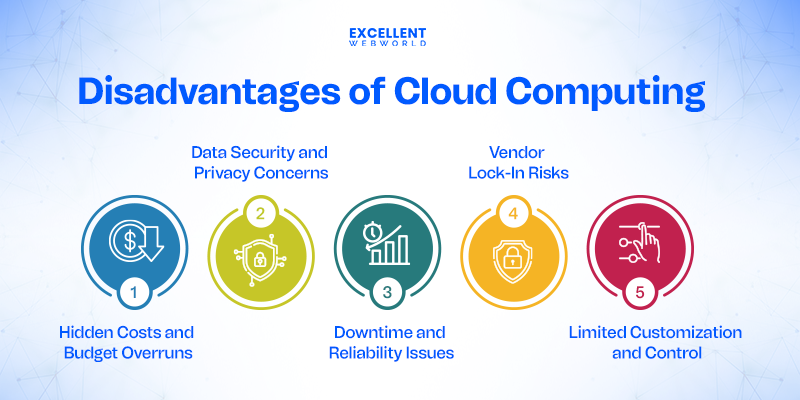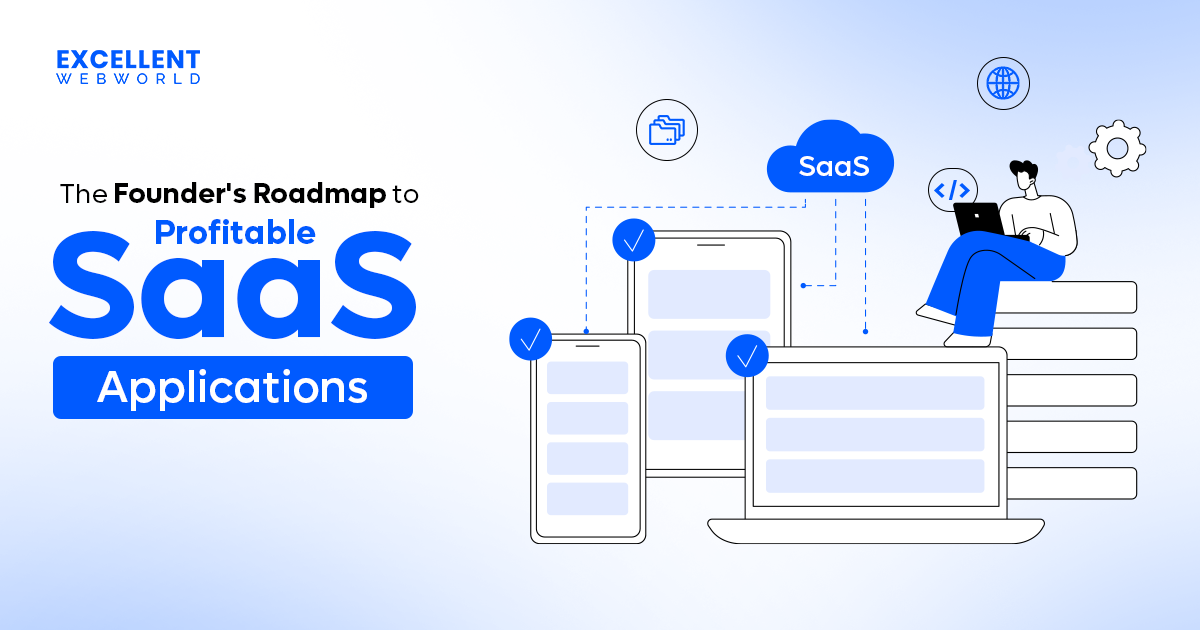What are the advantages of cloud computing? What are the disadvantages of cloud computing? As an enterprise decision-maker, you may be concerned about those two things. Additionally, high infrastructure costs, limited scalability, securities issues, and a lack of collaboration within your organization could contribute to your worries.
Cloud computing services can help you overcome these challenges. That’s the reason behind the widespread adoption of cloud services in industries like healthcare, fintech, ecommerce, etc.
According to a report, 69% of businesses use cloud computing services. Enterprises are increasingly drawn to cloud-based services because they provide benefits to counter risks. However, just like everything has a positive and negative side, while there are several advantages of cloud computing, there are disadvantages of cloud computing as well. And as a decision-maker, it’s crucial for you to understand these pros and cons before jumping the gun.
Go through the list below that comprises of advantages and disadvantages of cloud computing compiled by our team of cloud experts. It’ll help you evaluate whether or not it’s worth your investment.
What is Cloud Computing?
Cloud computing is a service that offers remote availability of computer systems and resources. Simply put, your data is saved on a remote server, which you can access from anywhere and anytime. There are three types of cloud deployment, which are based on the level of flexibility, control, and management:
Advantages of Cloud Computing
Cloud computing migration can transform your business and offer multiple benefits. If you are planning to move to cloud-based services, it is essential to know how companies benefit from them and how you can scale up your business.
Here is a list of top benefits and advantages of cloud computing that you need to consider.
Business Benefits of Cloud Computing
Cloud computing offers several business benefits, such as cost reduction, flexibility, enhanced collaboration, accessibility, reduced time to market, and improved security.
1. Cost Benefits of Cloud Computing
You only have to pay for the resources you use. According to Rightscale, 94% of enterprise organizations use cloud computing. Cloud computing services help you reduce initial hardware and software costs. You can save 30% annually on IT expenses after moving to the cloud.
Example: GE Oil & Gas migrates 350+ applications on AWS Cloud Services by using a rehost strategy. This reduces the cost of ownership by 52%.
2. Scalability and Resource Optimization
Cloud computing offers scalability and elasticity to scale your business at your own pace. You can quickly scale resources and storage up according to business demands, such as flash sales time traffic spikes. This also reduces the investment infrastructure.
Example: You can use a replatform strategy for scalability; even a taxi app called Gett app uses this strategy to scale its business. Also, you can scale your business for better cloud security and cost-effectiveness with Google Consulting Services from expert guidance.
3. Security Benefits of Cloud Computing
Cloud computing helps you to strengthen your security position with the depth and broadness of security features.
Here are some security features you should explore:
Example: Use adequate security during the migration with practices like web application firewall, next-generation firewall (NGFW) solution, and cloud access security broker (CASB).
4. Improved Collaboration and Accessibility
You can create a collaborative environment through cloud computing. Documents are stored in a specific location and accessible through a secure credential. Additionally, it makes the discussion seamless and ensures everyone is on the same page.
Example: The Aldo group development team used the AWS AppSync service. It handled accessibility, in-store communication, and access to the required data quickly.
5. Reliability Ensuring Business Continuity
Reliability ensures business continuity, which refers to uninterrupted cloud service delivery. Multi-cloud and serverless architecture also help accelerate the development of cloud computing.
Apart from that, there are several key aspects of reliability for business continuity:
Example: DigitalNZ sought a new strategy as the government requested to modernize on-premise infrastructure. They use an Agile cloud-migration approach to migrate to AWS and improve reliability.
Industry-Specific Benefits of Cloud Computing
Cloud computing offers numerous industry-specific benefits, too, which vary across sectors like healthcare, eCommerce, and fintech.
1. Benefits of Cloud Computing in Healthcare
Cloud computing in the healthcare industry improves its data storage, management, data backup, and data recovery. Apart from that, a good amount of data helps in better treatment.
2. Benefits of Cloud Computing in eCommerce
Leveraging cloud computing in eCommerce and organizations can be very beneficial. Here are some of the benefits of cloud computing in eCommerce.
3. Benefits of Cloud Computing in Fintech
Cloud computing is shaping the fintech industry with innovative and technical advancements. Take an example of the AI integration in FinTech apps. Such integrations have been pivotal in changing the entire user experience. With AI in FinTech financial services have become smarter than ever.
Below are some of the transformations of cloud computing that have driven the fintech industry’s growth forward.
4. Benefits of Cloud Computing in Logistics
Cloud computing is changing the supply chain management in logistics. It increases scalability, agility, improved decision-making, and risk management capability.
5. Benefits of Cloud Computing in EdTech
Cloud computing can be very beneficial for the EdTech industry, whether you are a regional education institution catering to or a global education institution. Here are some of the advantages you can leverage for your EdTech service.
Disadvantages of Cloud Computing
There are a few disadvantages or barriers that you need to know if you decide to use cloud computing for your business. However, we’ve provided the best solutions and tips to overcome these disadvantages.
General Disadvantages of Cloud Computing
The general barriers to cloud computing include connectivity issues, offline accessibility, and the potential for data leakage.
1. Hidden Costs and Budget Overruns
Hidden costs are a significant challenge you must manage while using cloud computing. These costs are increased due to coordination tools and staff expertise. You may also face increased network costs when transferring data between different environments.
Pro Tip
However, you can reduce it by cost analysis before migration and utilizing discounts from the cloud provider. Also, you need to monitor resource usage with the coordination tools.
2. Data Security and Privacy Concerns
As you already know, cloud service providers implement the best security and industry certifications, but storing data on external service providers opens up risks. One prominent example is the Code Space company, where the AWS EC2 console was hacked.
Pro Tip
However, you can minimize the concern by implementing robust access controls, encrypting the data, and conducting security audits. Also, go for multi-factor authentication; all these practices will help you address the security issue.
3. Downtime and Reliability Issues
According to a report by Uptime Institute, 31% of businesses experienced financial impact because of downtime. In 2023, several companies and services faced the same issue, including Microsoft, Google Cloud, AWS, and more.
Pro Tip
You can reduce downtime’s impact by implementing redundancy across various data centers, disaster recovery plans, multi-cloud architectures, and communication with users during outages.
4. Vendor Lock-In Risks
This is a situation where the vendor cannot switch to another vendor. This situation comes due to high switching costs and vast amounts of data that are difficult to migrate.
Pro Tip
You must prioritize cloud providers with easy data migration options and practice a multi-cloud strategy.
5. Limited Customization and Control
While using cloud computing, you may be restricted from updating or personalizing a product or service. You may also face limited predefined options set by the providers.
Pro Tip
You need to explore more options, like using different types of APIs and developer tools offered by the cloud provided. Also, go for cloud providers with flexible service tiers for on-demand customization.
Comparing the Advantages and Disadvantages of Cloud Computing
Let’s look into the advantages and disadvantages of cloud computing based on use cases, key matrices, cloud models, and more aspects for better clarity.
1. Use Case-Based Comparison
In this comparison, you’ll find industry-wise use cases that will help you better understand cloud computing according to your business needs.
| Aspect | Cost | Scalability | Data Security | Reliability |
|---|---|---|---|---|
| Small Businesses | Affordable & often discounted for new businesses | Less infrastructure investment leads to growth | Limited resources for strong security | Depending on the service providers |
| Enterprises | Depending on the company size & service usage, Expected 2.4M to 6M USD for big-size enterprises | Scales globally without significant infrastructure disruption | Strong in-house policies | Robust failover systems |
| Healthcare | Depending on the specific needs, Expected USD 25,000+ | Depends on the limitation by compliance needs | High risk of breaches and unauthorized access | Critical for patient data access |
| E-Commerce | Depending on factors like traffic volume, storage, cloud provider, and service level Expected 500+ USD per month with peak traffic period | Highly flexible, which depends on market demand and traffic spikes | Moderate security demands | Critical during sales events |
| Logistic | Adopting cloud supply chain management reduces costs by more than 10%. | Depends on demand, scale up or down | Cloud service needs to be ensured to provide all security measures to prioritize data security. | Should invest in premium networks to address downtime, which may affect the cost |
| Fintech | Pay for what they use, like the pay-as-you-go model | Scalability in fintech can be adjusted according to resource capacity based on business requirement | Centralized data management with high-level encryption | Depending on the infrastructure, service providers |
| EdTech | Managing bulk resources can reduce staff costs, and you can save licenses, power, hardware requirements, and support costs. | EdTech companies can provide capacity during peak usage times and scale back down. | Providers offer robust security features such as intrusion detection, threat intelligence, and automated patching mechanisms. | Service from multi-cloud providers to maximize features and avoid vendor lock-in. |
2. Key Metrics Comparison
Go through this table of pros and cons according to the key metrics of cloud computing.
| Feature | Advantage | Disadvantage |
|---|---|---|
| Uptime | 99.9% guaranteed by most providers, which indicates a high level of availability | Risk of outages that rely on national impacting operations |
| Cost Savings | 30% average savings on infrastructure | Hidden costs like cloud providers charge when data is moved out of their cloud storage |
| Data Backup | Automatic backups ensure quick recovery | Lack of control over backup frequency |
| Deployment Speed | Deployment in hours or days | It may require additional training |
| Security | Access to enterprise-grade tools | Increased risk of data breaches |
3. Comparison by Cloud Model
In this table, you’ll find a cloud model-based comparison, like the difference between IAAS, PAAS, and SAAS, to help you better understand cloud computing according to your business needs.
| Aspect | IaaS | PaaS | SaaS |
|---|---|---|---|
| Scalability | Highly customizable, scalable | Scalable development environments | Scales with user subscriptions |
| Control | Full control over infrastructure | Limited control over platform features | Minimal control over software setup |
| Cost | Pay-per-use with cost predictability | Pay-as-you-grow, moderate cost | Subscription-based, predictable |
| Security | Requires robust in-house security measures | Shared responsibility with the provider | Provider handles security fully |
4. Weighted Decision Matrix
This quantitative technique helps you choose the service according to the set criteria for your business needs. However, this is a hypothetical result based on multiple resources.
| Factor | Weight (%) | Advantage Score | Disadvantage Score | Net Score |
|---|---|---|---|---|
| Cost | 30% | 8/10 | 4/10 | +4 |
| Scalability | 25% | 9/10 | 3/10 | +6 |
| Security | 20% | 7/10 | 6/10 | +1 |
| Reliability | 25% | 9/10 | 2/10 | +7 |
| Overall | 100% | – | – | +18 |
5. Pros and Cons Across Cloud Providers
Significant advantages include cost efficiency, accessibility, recovery capabilities, and more. However, disadvantages you may face are vendor lock-in, fixed control over infrastructure, and more.
| Aspect | AWS | Azure | Google Cloud |
|---|---|---|---|
| Pricing | Pay-as-you-go with detailed billing | Competitive pricing, hybrid incentives | Simplified pricing models |
| Reliability | Market leader, proven uptime | Strong regional data centers | Industry-leading SLAs |
| Scalability | Unmatched range of scaling options | Integrated with the Microsoft ecosystem | Excellent for Kubernetes scaling |
| Security | Advanced security compliance frameworks | Industry-specific security options | Strong data encryption capabilities |
| Database Service | Aurora, RDS, DynamoDB, ElastiCache, Redshift, Neptune database | SQL, MySQL, PostgreSQL, Data Warehouse, Cosmos DB, data factory | Cloud SQL, Cloud Bigtable, Cloud Spanner, Cloud DataStore |
| Serverless Computing | Lambda | Functions | Google Cloud Functions |
| Networking | Amazon Virtual Private (VPC) | Azure Virtual Network (VNET) | Cloud Virtual Network |
Factors to Consider Before Moving to the Cloud
You need to consider multiple factors before choosing the right cloud model and provider to get the business benefits of cloud computing.
Here is the list of factors:
Where To Start With Cloud Computing Integration?
The above article should have helped you understand all the advantages and disadvantages of cloud computing. However, one critical aspect of this process is integrating cloud computing and the nuances of expertise. Excellent Webworld is an experienced cloud application development company with industry expertise.
We have over 13 years of experience providing cloud computing development services. Our team of experts has successfully developed high-performance apps that integrate cloud computing technologies. With more than 900 successful projects, our experts have catered to different client needs in cloud computing.
We are a leading cloud application development company that offers end-to-end development. Contact us now to learn more about our solutions.
FAQs: Answers to Common Cloud Computing Concerns
Cloud computing differs from traditional IT infrastructure as it offers flexibility, scalability, and a more cost-effective approach through a network.
Cloud computing is considered a game changer because of the numerous benefits, such as agility and scalability, that can scale up or down businesses according to demands, costs, and sustainability.
The cost of cloud computing services includes data storage costs, network transfer fees, database costs, API calls fees, support costs, exit or switching fees, and more.
Several hidden costs can affect your business, and you should consider geographical location, data transfer fees, compliance costs, potential fees, and more.
If the cloud provider goes out of business, data loss may occur; you need to take proactive steps to back up or transfer to another provider.
Yes, cloud computing allows you to scale the business in the long term, and you can consider this for long-term business.
To select a reliable cloud provider, you must carefully evaluate security measures, compliance with industry standards, pricing, service level agreements (SLAs), customer support, and privacy requirements.
Excellent Webworld’s team of experts has more than 13 years of experience in cloud computing development services. They have successfully developed high-performance apps that integrate cloud computing technologies.

Article By
Mayur Panchal is the CTO of Excellent Webworld. With his skills and expertise, He stays updated with industry trends and utilizes his technical expertise to address problems faced by entrepreneurs and startup owners.





